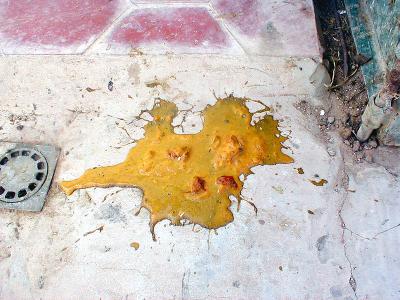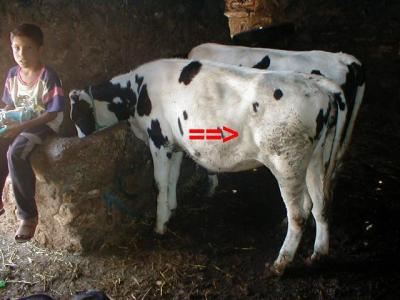
|
East Coast Fever
Local names:
Gikuyu: ngai /
Kamba:ngai /
Embu: ngai /
Gabbra:shilmi dimtu /
Maasai: oltikana, oldigana /
Kipsigis: sosoito /
Swahili: ndigana /
Turkana: lokit, loleeo, lipis /
Iteso: angaarwei /
Luidakho: yapwolo /
Luvugusu: gamavumba /
Nandi: cheptigonit /
Pokot: cheptikon, lipis /
Maragoli: ivitu, evivitu /
Meru: ita /
Samburu: lipis /
Common names:
Theileriosis, African coast fever, lafievre de la cote orientale (French), fiebre de la costa oriental Africana (Spanish)
Description:
Insect borne disease
|
Introduction
The disease is also referred to as Theileriosis. It is a serious febrile disease of cattle transmitted by the brown ear tick and the red legged tick. The infective tick Rhipicephalus appendiculatus usually attaches to the ear and thus called brown ear tick. The disease occurs in east and central Africa. Other forms of the disease are widespread in tropical and subtropical regions of Africa, Asia and southern Europe.
It is caused by a protozoan parasite Theileria parva which invades the lymphatic glands. Incubation varies between 1-3 weeks after exposure to infective ticks.
Signs of East Coast Fever
|
Signs
In the event of infection, the parotid lymphnodes below the ear become enlarged 1 - 2 weeks after infection. A few days later, fever develops along with enlargement of superficial lymphnodes in front of shoulder and stifle.
Other signs may include: difficult breathing, soft cough due to accumulation of fluid in the lungs, blood stained diarrhea, muscle wasting and white discoloration of the yes and gums. Cows may appear disturbed resulting in the so called "turning sickness" and paralysis.
Diagnosis
Blood smear and gland (biopsy) smears should be taken for laboratory analysis by a qualified vet to confirm the disease.
|
|
Prevention - Control - Treatment
Prevention and Control
Regular dipping of cattle should be maintained. However, this may be difficult to attain in open herds without proper organization. Treatment o clinical signs as they appear in extensive herds.
The use of live vaccines of East Coast Fever is effective but may cause clinical disease.
Infection and treatment with antibiotics such as long acting oxytetracycline provides immunity.
Recommended treatment
The following treatments should be administered by trained personnel:
- Parvaquone ( trade name Clexon) should be administered in the muscle at 20 mg/kg bodyweight at 2 days interval. Buparvaquone (trade name Butalex) at 5 mg/kg body weight or 2.5 mg/kg body weight at repeat dose.
- Halofuginone ( Terit trade name) an anti coccidiosis drug administered orally is quite effective at 1 mg/kg body weight. The treatment is more effective if done at early stages of the disease.
- Oxytatracycline such as oxytetracycline long acting, terramycin administered at 50 mg/kg body weight deep in the muscle.
Information Source Links
- Blowey, R.W. (1986). A Veterinary book for dairy farmers: Farming press limited Wharfedale road, Ipswich, Suffolk IPI 4LG
- Barber, J., Wood, D.J. (1976) Livestock management for East Africa: Edwar Arnold (Publishers) Ltd 25 Hill Street London WIX 8LL
- Force, B. (1999). Where there is no Vet. CTA, Wageningen, The Netherlands. ISBN 978-0333-58899-4.
- Pagot, J. (1992). Animal Production in the Tropics and Subtropics. MacMillan Education Limited London
- Hunter, A. (1996). Animal health: General principles. Volume 1(Tropical Agriculturalist) - Macmillan Education Press. ISBN: 0333612027
- Hunter, A. (1996). Animal health: Specific Diseases. Volume 2(Tropical Agriculturalist) - Macmillan Education Press. ISBN:0-333-57360-9
- Blood, D.C., Radostits, O.M. and Henderson, J.A. (1983) Veterinary Medicine - A textbook of the Diseases of Cattle, Sheep, Goats and Horses. Sixth Edition - Bailliere Tindall London. ISBN: 0702012866
- Hall, H.T.B. (1985). Diseases and parasites of Livestock in the tropics. Second Edition. Longman Group UK. ISBN 0582775140
- ITDG and IIRR (1996). Ethnoveterinary medicine in Kenya: A field manual of traditional animal health care practices. Intermediate Technology Development Group and International Institute of Rural Reconstruction, Nairobi, Kenya. ISBN 9966-9606-2-7.
- The Organic Farmer magazine No. 50 July 2009

 Back
Back

